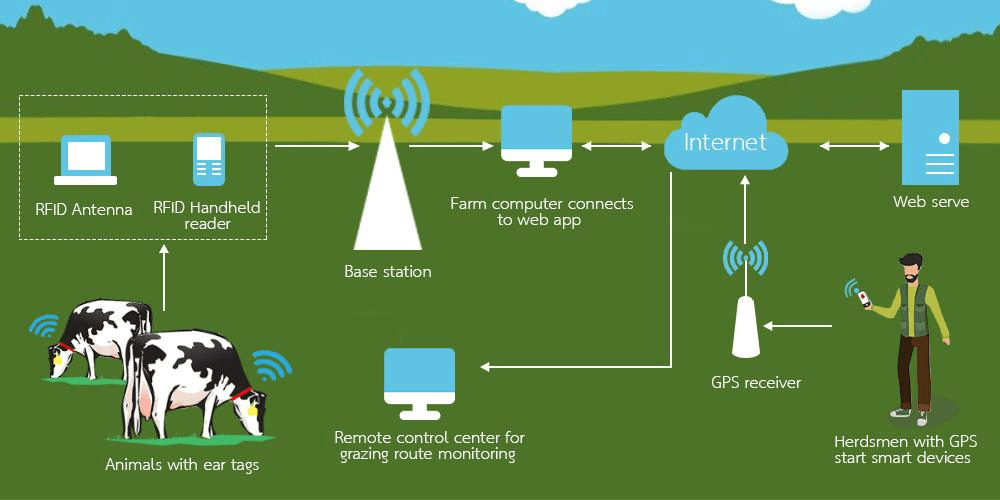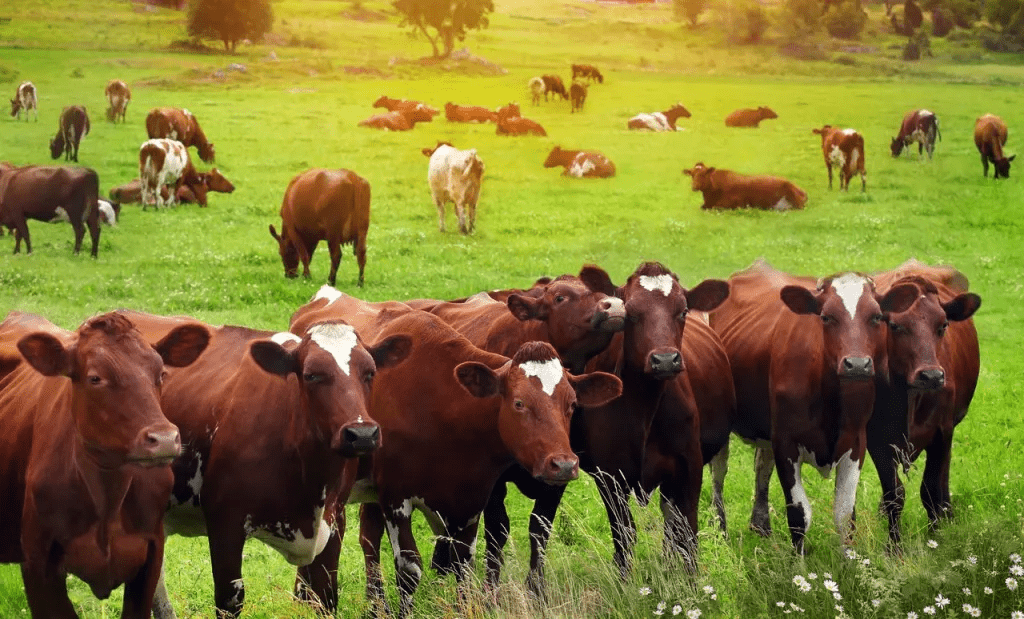Overview of Livestock Management
Livestock management is a crucial aspect of agriculture and animal husbandry. A part of animal science, it involves the care and breeding of animals for various purposes, including beef, milk, eggs, and wool. Successful livestock management requires a combination of knowledge, skills, and resources.
As someone who has spent many years working on a ranch, I know firsthand how rewarding and challenging livestock management can be. It’s a demanding job that requires a lot of patience, dedication, and knowledge.
But it’s also incredibly satisfying to see your animals thrive and produce healthy offspring. Let me share some of the most authentic and useful tips to improve your livestock management tasks.
Importance of Efficient Livestock Management for Agricultural Success
Efficient livestock management is essential for the success of agricultural businesses. It can help to increase productivity, reduce costs, and improve animal welfare. By implementing effective management practices, farmers can maximize their returns on investment and ensure the sustainability of their operations.
I’ve seen firsthand the benefits of efficient livestock management. When farmers take good care of their animals, they tend to be healthier and more productive. This can lead to higher yields and lower costs, which is essential for profitability.
Challenges in Livestock Management
Livestock management can be challenging due to a variety of factors, including:
- Disease and pests: Animals such as cattle and sheep are susceptible to a wide range of diseases and pests, which can negatively impact their health and productivity.
- Climate change: Climate change is having a significant impact on agriculture, including livestock production. Changes in temperature, rainfall patterns, and extreme weather events can pose challenges for livestock farmers.
- Market fluctuations: The prices of livestock products can fluctuate significantly, making it difficult for farmers to plan their operations and manage their finances.
One of the biggest challenges I’ve faced as a livestock farmer is dealing with unexpected problems. Whether it’s a disease outbreak, a natural disaster, or a sudden drop in market prices, it’s important to be prepared and have a plan in place to deal with these challenges.
Overall, livestock management is a complex and rewarding endeavor. It requires a combination of knowledge, skills, and resources. By implementing effective management practices, farmers can ensure the success and sustainability of their operations.
Tip 1: Strategic Feeding and Nutrition
Understanding Nutritional Needs of Different Livestock Species
Livestock species have varying nutritional requirements based on factors such as age, size, breed, and reproductive status. For example, growing calves require more protein and energy than mature cows, while lactating dairy cows need a higher intake of calcium and phosphorus to support milk production.
Creating a Balanced Diet Plan
A well-balanced diet is essential for optimal livestock health and performance. It should provide adequate amounts of energy, protein, carbohydrates, fats, vitamins, and minerals. Factors to consider when creating a diet plan include the quality and availability of feed-stuffs, the quality of forage, the cost of feed, and the specific needs of the livestock.
Supplementing with Vitamins and Minerals
In some cases, it may be necessary to supplement livestock diets with vitamins and minerals. This can be particularly important during periods of stress, such as breeding, calving, or lactation. Common supplements and medications include animal freindly antibiotics, vitamin A, vitamin D, vitamin E, calcium, phosphorus, and selenium.
The Role of Grazing vs. Supplemental Feed
Grazing can be a cost-effective way to provide livestock with nutrients. However, the efficiency of pasture can vary depending on factors such as soil fertility, weather conditions, and grazing pressure. In some cases, it may be necessary to supplement grazing with additional feed, such as hay, grain, or concentrates.
As a livestock farmer, I’ve learned the importance of providing my animals with a balanced and nutritious diet. By understanding their specific needs and tailoring their feed accordingly, I’ve been able to improve their health, productivity, and overall well-being.
Tip 2: Effective Breeding Practices
Selecting the Right Breeding Stock
Choosing the right breeding stock is crucial for improving the genetic quality of a livestock herd. Factors to consider when selecting breeding animals include their health, conformation, pedigree, and performance records.
Monitoring Reproductive Health
Reproductive health is essential for successful breeding. It’s important to monitor the reproductive health of both males and females to identify and address any problems that may affect their ability to reproduce. This can involve regular physical examinations, testing for diseases, and tracking estrus cycles.
Managing Breeding Cycles
Effective breeding cycle management can help to optimize calving or lambing intervals and ensure that animals are in peak condition for breeding. This may involve using hormones to synchronize estrus, controlling breeding dates, and implementing appropriate nutrition and management practices.
Improving Breeding through Genetic Selection
Genetic selection can be used to improve the genetic traits of livestock, such as growth rate, milk production, or meat quality. This involves selecting and breeding animals with desirable traits to pass these traits on to their offspring. Genetic selection can be enhanced through the use of performance testing and genetic evaluations.
As a livestock farmer, I’ve seen firsthand the importance of effective breeding practices. By selecting the right breeding stock, monitoring reproductive health, and managing breeding cycles, I’ve been able to improve the quality and productivity of my herd.
Tip 3: Health and Disease Management
Regular Veterinary Check-ups
Regular veterinary check-ups are essential for maintaining the health and well-being of your livestock. A veterinarian can identify and address potential health problems before they become serious. They can also provide advice on vaccination schedules, nutrition, and other aspects of livestock care.
Vaccination Protocols for Livestock
Vaccinations can help to protect your livestock from a variety of diseases. It’s important to consult with your veterinarian to determine the appropriate vaccination schedule for your specific herd. Factors to consider include the age, breed, and location of your animals.
Identifying Common Diseases and Prevention
There are many common diseases that can affect livestock. It’s important to be aware of the signs and symptoms of these diseases so that you can take steps to prevent and treat them. Some common livestock diseases include mastitis, foot-and-mouth disease, and respiratory infections.
Quarantine and Treatment for Affected Animals
If you suspect that one of your animals is sick, it’s important to isolate it from the rest of the herd to prevent the spread of disease. Consult with your veterinarian to determine the appropriate course of treatment. In some cases, it may be necessary to euthanize an animal that is severely ill or contagious.
By providing regular veterinary care, vaccinating my animals, and being vigilant about disease prevention, I’ve been able to maintain a healthy and productive herd.
Tip 4: Proper Housing and Shelter
Designing Optimal Livestock Greenhouse
In agribusiness industry, a well-designed housing is essential for the health, comfort, and productivity of livestock. Factors to consider when designing livestock housing include the climate, the type of livestock, and the specific needs of the animals.
Providing Adequate Space and Ventilation
Livestock need sufficient space to move around and express natural behaviors. Adequate ventilation is also important to maintain good air quality and prevent the buildup of harmful gases.
Seasonal Considerations: Summer and Winter Shelters
Different types of shelters may be needed for summer and winter. Summer shelters should provide shade and protection from insects, while winter shelters should be warm and draft-free.
Importance of Cleanliness and Sanitation in Housing
Regular cleaning and sanitation of livestock housing can help to prevent the spread of disease and parasites. This includes removing manure, cleaning feeders and waterers, and disinfecting surfaces.
As a livestock farmer, I’ve seen firsthand the importance of providing my animals with adequate housing. By designing and maintaining appropriate shelters, I’ve been able to improve their health, comfort, and productivity.
Tip 5: Efficient Record-Keeping and Farm Management
Tracking Livestock Growth and Health Data
Accurate record-keeping is essential for effective livestock management. By tracking data such as birth dates, weights, vaccinations, and health records, you can monitor the growth and development of your animals and identify any potential health problems.
Maintaining Financial Records and Budgets
Financial records are crucial for understanding the profitability of your livestock operation. This includes tracking income, expenses, and calculating your net profit or loss. Creating a budget can help you to plan for future expenses and manage your finances effectively.
Utilizing Technology in Livestock Monitoring
Technology can be a valuable tool for livestock management. For example, you can use software to track animal health records, monitor feed intake, and manage breeding cycles. There are also a variety of wearable devices that can be used to track the location and behavior of livestock.
Managing Labor and Daily Operations
Efficient labor management is essential for the smooth operation of a livestock farm. This includes scheduling tasks, assigning responsibilities, and ensuring that employees have the necessary training and equipment. Effective daily operations planning can help to maximize productivity and minimize downtime.
As a livestock farmer, I’ve found that efficient record-keeping and farm management are essential for success. By tracking data, managing finances, and utilizing technology, I’ve been able to improve the profitability and sustainability of my operation.
Conclusion
Successful livestock management requires a combination of knowledge, skills, and resources. By following the tips outlined in this blog post, you can improve the health, productivity, and profitability of your livestock operation.
Recap of the 5 Must-Know Tips for Livestock Management
- Strategic Feeding and Nutrition: Provide your livestock with a balanced diet that meets their specific nutritional needs.
- Effective Breeding Practices: Select the right breeding stock, monitor reproductive health, and manage breeding cycles effectively.
- Health and Disease Management: Implement regular veterinary check-ups, vaccination protocols, and disease prevention measures.
- Proper Housing and Shelter: Ensure that your livestock have adequate space, ventilation, and protection from the elements.
- Efficient Record-Keeping and Farm Management: Track livestock data, maintain financial records, and utilize technology to improve your operations.
Long-term Benefits of Implementing These Practices
By consistently implementing these practices, you can achieve significant long-term benefits, including:
- Improved animal health and welfare: Healthy animals are more productive and less susceptible to disease.
- Increased profitability: By optimizing your livestock management practices, you can reduce costs and increase your returns on investment.
- Enhanced sustainability: Sustainable livestock practices can help to protect the environment and ensure the long-term viability of your operation.
As a livestock farmer, I’ve seen firsthand the benefits of implementing these tips. By focusing on animal welfare, productivity, and sustainability, I’ve been able to build a successful and rewarding business.




